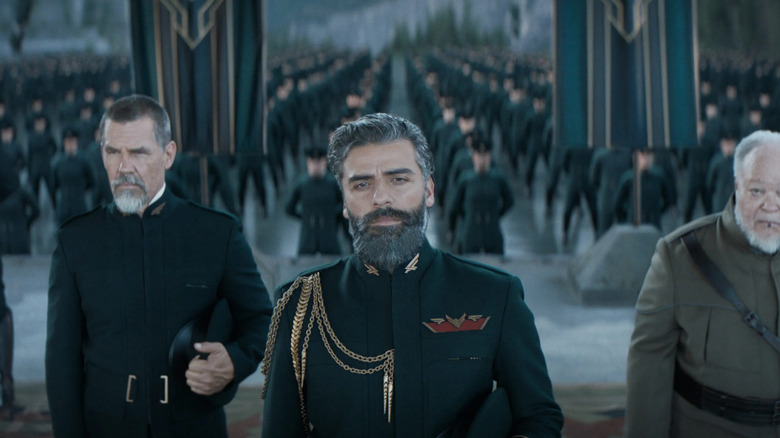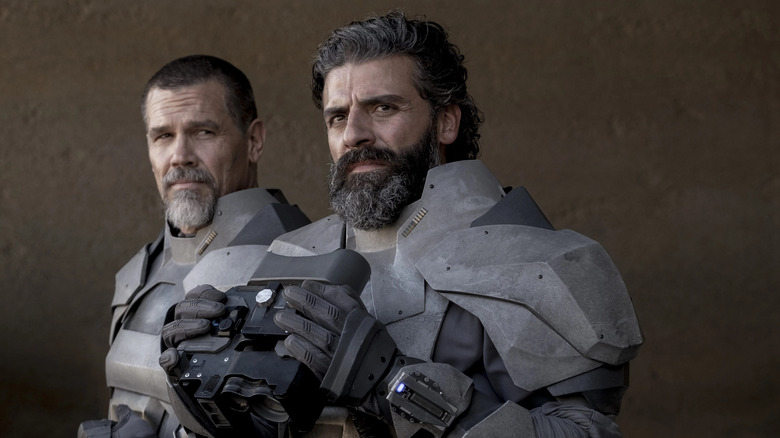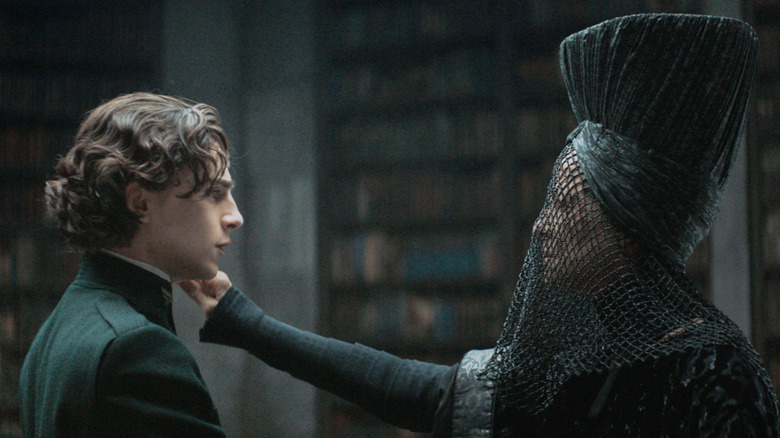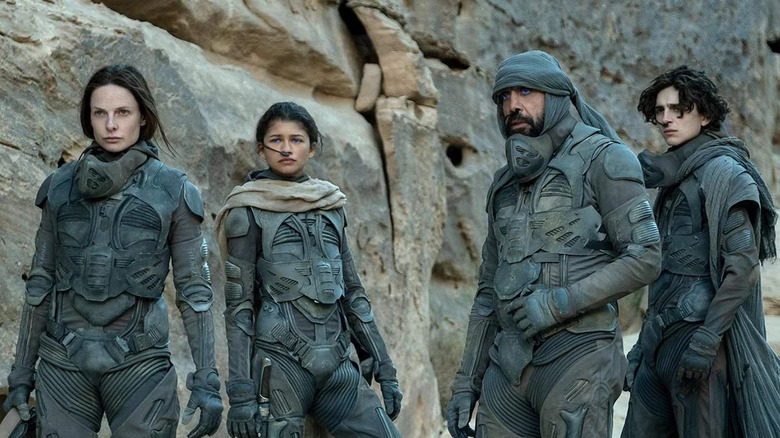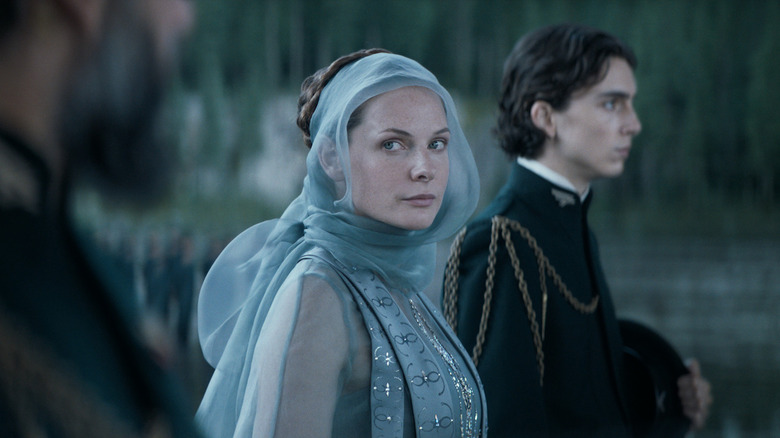If Dune's Costumes Weren't Right, Nothing Else Was Going To Work
The story of adapting Frank Herbert's sci-fi epic "Dune" is as tragic and winding as the exposition of the novel itself. But decades after David Lynch's campy '80s version seemed to solidify the tale as unadaptable, Denis Villeneuve did just that with his 2021 film.
One of the many laurels heaped atop his "Dune" is its stunning visual aesthetics which, like the director's previous sci-fi installments "Blade Runner 2049" and "Arrival," emphasized a need for making the futuristic feel lived-in and ancient. But that vision would not have been realized without the many people at Villeneuve's side throughout the colossal effort of making Herbert's worlds a reality. Costume Designer Jacqueline West ("The League of Extraordinary Gentleman," "The Revenant") was one such instrumental figure.
Ironically enough, when Villeneuve approached her to work on "Dune" she said no because of her lacking sci-fi experience, even citing the fact that she'd never seen "Star Wars." But the director only saw this as an indication that West could create organically distinct costumes for the characters of "Dune." Without her or fellow costume designer Bob Morgan's eye, Villeneuve's adaptation might've faced a similar mediocrity afforded to previous versions.
Costume designer Jacqueline West's connection with Dune
Despite not working on a sci-fi project before "Dune," West was by no means unfamiliar with the source material. But unlike her work on "The Revenant," which benefited from written accounts of the clothing trappers and native tribes wore, Herbert's novel doesn't scrupulously detail the outfits worn by his characters. "With Dune, it wasn't so much description but this feeling it gives you," West told The Hollywood Reporter "Frank Herbert didn't go into those kinds of descriptions. He created a feeling." She continued:
"I had some feeling for it too, though, I suppose. I'm from Berkeley and Frank Herbert wrote it in the area. In fact, he famously wrote a lot of Dune on Allan Watts' houseboat in Sausalito Harbor, and my family's houseboat was just 30 feet away from Alan's when I was a kid. Then I went to [the University of California,] Berkeley years later and everyone was reading it. Dune was like a bible back then. They even sold it at the Whole Earth Access store. So I always felt I had a connection with it."
Like Villeneuve, it's evident that reverence for the novel was grounding for West. When she explained to the director her "feeling" for what "Dune" should look like, telling him she wanted to "look to the past — the distant, distant past — to find a style for this movie," he realized he'd chosen the perfect person to costume Herbert's universe. West even attributes this to why Villeneuve wanted a designer with mainly period experience in the first place. What better person for the job was there than one who could draw on humankind's ancient history to supply an uncanny vision of a distant sci-fi future?
Dune borrowed from medieval style and tradition
West would call her melding of past and future "mod-ieval" – a "modern take on medieval times." This was fitting given the fact that many elements of medieval Europe, from the pageantry of the feudal system to its bloody politics, fill Herbert's novel. West told Vogue that Villeneuve's "Dune" had "no aliens, no silver gadgets" and focused on having primarily historical reference points. When designing the outfits of House Atreides she even cast her eye back to the Greek tragedies and doomed royals like the Romanovs.
"We're dealing with the downfall of a monarchy, so the Romanovs were the obvious reference. Their uniforms were so elegant, and I referred to that for Paul, Duke Leto, and all the men of Caladan."
But the noblemen of Atreides weren't the only ones to get the medieval treatment.
"The textured black leather of some of the Harkonnen costumes all came from ideas of insects, lizards, and spiders," West said, telling The Hollywood Reporter she was inspired by drawings by medieval monks of different creatures. "I'd read the Frank Herbert notes in which he mentions that Baron Harkonnen's mother was called 'the Black Widow' and that she was spider-like, so that gave me a hint there. The Harkonnen helmet came from a giant ant head."
Beyond monks, West also used the pomp of the medieval clergy for inspiration. The Space Guild, with its white robes and dome-headdresses, was fashioned after the Avignon Papacy; and the mystic cult of the Bene Gesserit, as well as its leader Mother Mohiam, were concocted using ancient Marseilles tarot cards. But all these fashion anachronisms feel paradoxically at home in "Dune," where swords are a far more common weapon than guns and the advancement of certain technologies has been halted.
Creating the iconic stillsuits
If there was one outfit West had to absolutely nail, it was the stillsuit. The first thing she came up with was its color, a grey-beige hue that matched color samples taken from the Jordan desert where some Arrakis scenes were filmed.
West also had the help of Jose Fernandez, a sculptor who created legions of superhero outfits and iconic armor pieces. "The [stillsuits] are essentially survival gear for the harsh environment on Arrakis, [but] we were also filming in extreme temperatures," he explained to Vogue. "So they have to look like a functioning water distillery while allowing the actors to move and do their choreography." To that end, West started wrapping the suits in gauze to keep sand out of the actor's faces, a method she borrowed from the Tuareg people of the Sahara.
Once designed, they still needed to create tailored fits for every actor, which led to 250 form-fitted stillsuits for everyone in the cast. The arduous labor of it all was worth it when West got to see all the actors try on their suits for the first time.
"The first time we had everyone try them on was just incredible, Timotheé [Chalamet] started crawling on the floor and doing his sand walk, then Rebecca [Ferguson] was practicing her jiujitsu. It was so gratifying to see not just how great they looked but also how their body language changed once they were wearing them."
That kind of instantaneous transformation, especially when catalyzed by a costume, is what designers like West live for. It also underscores just how indelible the outfits actors wear onstage are to not just the film or audience experience — but in its tangible effect upon the actors wearing them.
Costuming helped Rebecca Ferguson embody Lady Jessica
For Rebecca Ferguson, the costumes designed by West were crucial in helping her embody Lady Jessica. They offered a depth she could assimilate to — like her outfit during Paul's Gom Jabbar test. "There was one dress that was like a shell of protection," Ferguson told Vogue. "[Its shape] was almost like a black sock, and when you pulled its hood up and backed into a corner, it allowed you to be completely hidden." Each of her outfits helped the actor cement in her mind who Lady Jessica was. Ferguson continued:
"She's someone who stands in the background hidden and reads everyone's emotions, and she knows the truth and is whispering it in her husband's ear."
Then there are her opulent masks and veils, which Ferguson saw as reminders that Lady Jessica is not regarded as nobility in House Atreides. She told The Hollywood Reporter:
"She gets to wear the regal clothes, but when we meet her, she's still in chains. There is still a big hierarchal difference between her and the men making all of the decisions. She has this eye pendant that is a wonderful symbol of that and is paired with a gorgeous veil. Jessica gets to be in the big room, but there are no other women there. Still, she has power and can kill anyone with a snap of her fingertips."
West helped the actor visualize that covert ferocity by cloaking her in outfits divined via romantic and baroque painters — "a lot of Goya, Caravaggio, Giotto."
Bene Gesserit, lover — Lady Jessica's conflicting loyalties make her one of the film's emotionally complex roles. As she did for Ferguson, West's costumes helped the actors connect to their characters and the universe of "Dune" quite intimately, which is a vital reason the film was so jaw-droppingly spectacular.
